Solar Energy Market Research, 2034
The global solar energy market was valued at $0.4 trillion in 2024, and is projected to reach $1.6 trillion by 2034, growing at a CAGR of 15.2% from 2025 to 2034.
Solar energy is the radiant light and heat emitted by the sun, which can be harnessed using a range of evolving technologies such as solar photovoltaics (PV), concentrated solar power (CSP), solar thermal systems, and solar heating applications. It represents one of the most abundant, renewable, and sustainable forms of energy available to humankind. As compared to fossil fuels, solar energy is non-polluting, inexhaustible in human timescales, and plays a critical role in combating climate change by reducing carbon emissions. The fundamental principle of solar energy utilization lies in converting sunlight into usable energy whether it be electricity, heat, or chemical energy for fuel production using advanced materials and engineering systems.
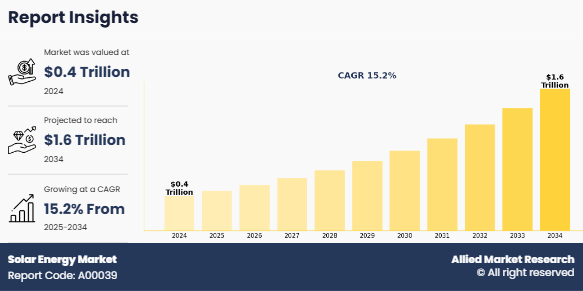
Introduction
Solar energy is the radiant energy emitted by the sun that can be harnessed and converted into usable forms of power, such as electricity or heat. It is a renewable, abundant, and sustainable source of energy captured using technologies like solar photovoltaic (PV) panels for electricity generation and solar thermal systems for heating applications. solar energy plays a crucial role in reducing dependence on fossil fuels and minimizing greenhouse gas emissions, making it a key component of global clean energy initiatives.
Key Takeaways
- The global solar energy market has been analyzed in terms of value ($billion). The analysis in the report is provided on the basis of technology, solar module, application, end-use, and 4 major regions, and more than 15 countries.
- The global solar energy market report includes a detailed study covering underlying factors influencing the industry opportunities and trends.
- The key players in the solar energy market include Enphase Energy, Inc, SunPower Corporation, JinkoSolar Holding Co., Ltd, First Solar, Inc, Trina solar, Canadian Solar, Hanwha Q CELLS Co., Ltd, SolarEdge Technologies, JA Solar Holdings Co. Ltd, Yingli Green Energy Holding Company Limited.
- The report facilitates strategy planning and industry dynamics to enhance decision making for existing market players and new entrants entering the alternators industry.
- Countries such as China, the U.S., Canada, Germany, and Brazil hold a significant share in the global solar energy market.
Market Dynamics
The industrial sector is increasingly adopting solar energy to improve energy efficiency and reduce operational costs. Manufacturing industries with high electricity demand, such as cement, glass, and steel production, can integrate solar PV systems or CSP units to partially offset their energy requirements. In adittion, solar energy plays a critical role in agriculture. Solar-powered irrigation systems, water pumps, and greenhouse heating allow farmers to reduce energy costs while promoting sustainable agricultural practices. For instance, solar-powered drip irrigation systems help conserve water and ensure efficient energy use in water-scarce regions.
The solar energy market is segmented into technology, solar module, application, end-use, and region. On the basis of technology, the market is divided into photovoltaic systems, and concentrated solar power systems (parabolic through, solar power tower, fresnel reflectors, and dish stirling. On the basis of solar module, the market is categorized into monocrystalline, polycrystalline, cadmium telluride, amorphous silicon cells, and others. On the basis of application, the market is categorized into residential, commercial, and industrial. On the basis of end-use, the market is classified into electricity generation, lighting, heating, and charging. Based on region, the market is analyzed across North America, Europe, Asia-Pacific, Latin America, the Middle East, and Africa.
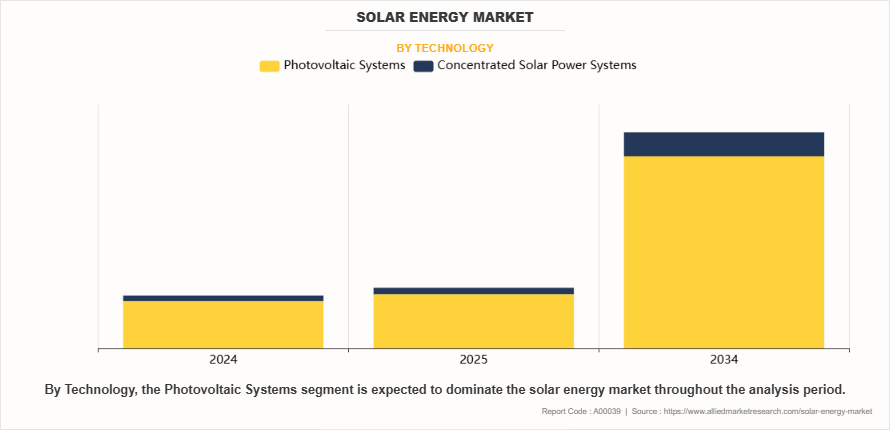
On the basis of technology, photovoltaic systems segment dominated the solar energy market accounting for more than half of the share in 2024. PV systems are versatile and can be deployed in various configurations depending on the energy requirements and available space. They are commonly installed as rooftop systems on homes and commercial buildings, ground-mounted systems for large-scale solar farms, and even integrated into building materials such as solar windows and facades. In addition, off-grid PV systems are used in remote or rural areas where access to centralized electricity is limited, providing clean and reliable power for lighting, irrigation, communication, and other essential services. The modular nature of PV technology enables easy scalability from small kilowatt-level installations to gigawatt-scale utility projects.
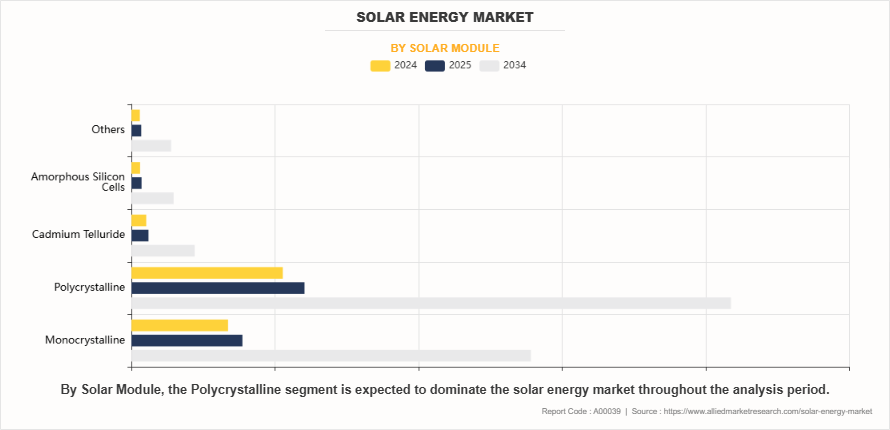
On the basis of solar module, polycrystalline segment dominated the solar energy market accounting for more than one fourth of the market share in 2024. The use of polycrystalline solar panels in the solar energy industry has been extensive because they offer reliable energy output with a moderate efficiency rate, typically ranging between 15% and 17%. Although slightly less efficient than monocrystalline panels, their lower production cost makes them ideal for large-scale projects where space is not a constraint. They are widely deployed in solar farms, rooftop systems, and community solar projects, especially in regions where cost sensitivity is high and land availability allows for broader installations.
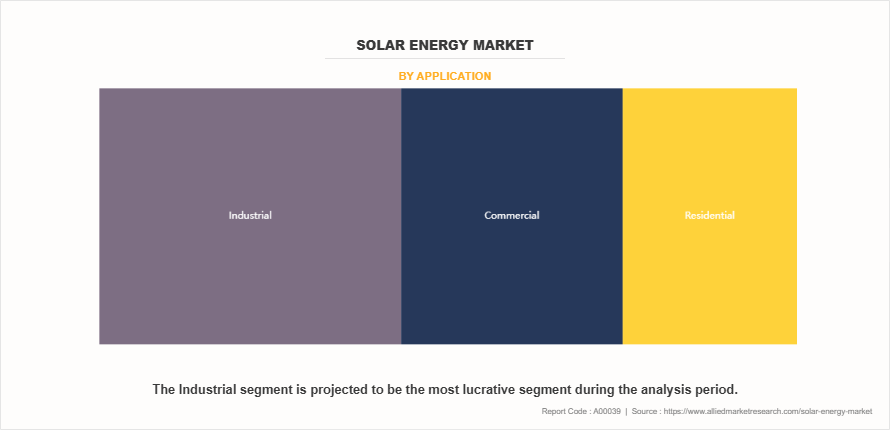
On the basis of application, industrial segment dominated the solar energy market in 2024. One of the primary uses of solar energy in industrial operations is electricity generation through rooftop or ground-mounted PV installations. Many factories and warehouses install large-scale solar arrays to meet a substantial portion of their power demand during daylight hours. This energy can be used to run machinery, lighting systems, conveyor belts, and other high power equipment. Some industries also adopt hybrid systems, combining solar power with grid supply or backup generators, ensuring uninterrupted energy availability even during cloudy conditions or peak hours.
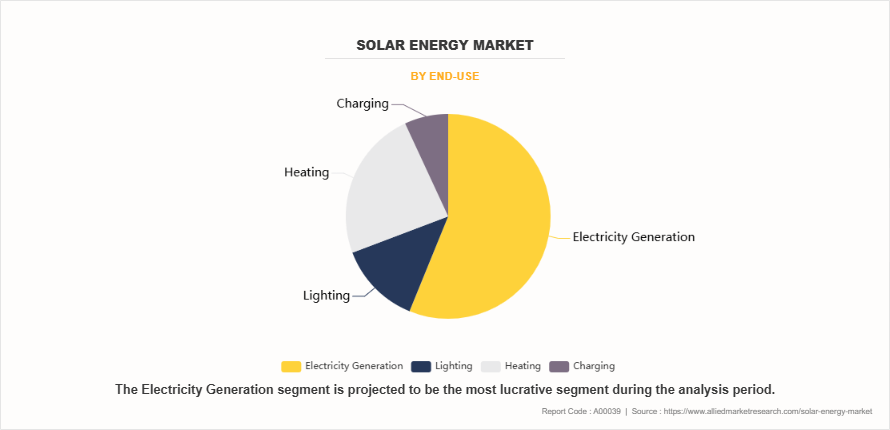
On the basis of end-use, electricity generation segment dominated the solar energy market in 2024. Solar energy plays a crucial role in electricity generation by converting sunlight directly into electrical energy through photovoltaic (PV) cells or indirectly via concentrated solar power (CSP) systems. It has emerged as one of the fastest-growing renewable energy sources worldwide, driven by advancements in solar technologies, declining installation costs, and supportive government policies. Solar PV systems are now widely used across residential, commercial, and utility scale applications to generate clean and sustainable electricity, reducing dependence on fossil fuels and mitigating greenhouse gas emissions.
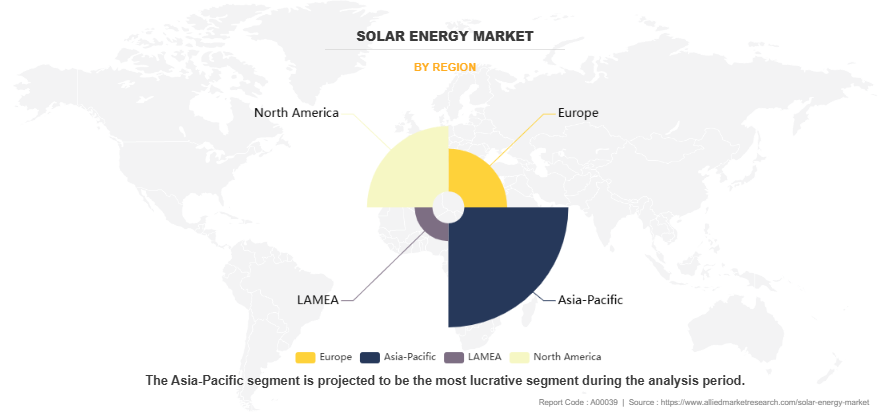
On the basis of region, Asia-Pacific segment dominated the solar energy market accounting for more than one third of the market share in 2024. China leads the global solar industry, accounting for more than one-third of the world’s installed solar capacity. The country’s government has heavily supported solar manufacturing and deployment through subsidies, feed-in tariffs, and renewable portfolio standards. Massive solar farms in provinces such as Qinghai, Inner Mongolia, and Gansu contribute significantly to China’s renewable power generation. In addition, China dominates the solar supply chain, manufacturing around 80–90% of global photovoltaic modules and components.
Integration of solar energy with smart technologies is expected to drive the growth of solar energy market. The adoption of solar energy has been greatly enhanced through its integration with smart technologies. By linking solar systems with the Internet of Things (IoT), smart meters, and advanced energy management systems, users can track and optimize their energy usage in real time. Smart meters offer detailed data on electricity generation and consumption, allowing both households and businesses to adjust their energy practices for greater efficiency and cost savings. In May 2025, Heelstone Renewable Energy expanded its U.S. footprint by acquiring Valor Infrastructure’s 190MWp solar photovoltaic (PV) pipeline in Texas. This strategic acquisition boosted Heelstone’s renewable energy portfolio, bringing its total operational and pipeline capacity in the U.S. to .over 5‐¯GW.
However, high initial installation and infrastructure costs is expected to hamper the growth of solar energy market. Despite the significant decline in solar panel prices over the past decade, high initial installation and infrastructure costs remain a major restraint for solar energy adoption. While panels themselves have become more affordable due to technological advancements and economies of scale, the total cost of a solar project involves much more than just the modules. Expenses such as inverters, mounting systems, wiring, labor, and engineering services contribute substantially to the upfront investment. For large-scale utility projects, the costs of land acquisition, site preparation, and grid integration can further escalate the financial burden. Even residential or commercial rooftop installations, while smaller in scale, require careful planning, permits, and professional installation, which can make the initial investment prohibitive for many consumers.
The major prominent players operating in the solar energy market include SolarEdge Technologies, SunPower Corporation, Trina solar, Enphase Energy, Inc, JinkoSolar Holding Co., Ltd, Trina solar, First Solar, Inc, SunPower Corporation, Yingli Green Energy Holding Company Limited, First Solar, Inc, and others.
Segments Overview
The solar energy market is segmented into technology, solar module, application, end-use, and region. On the basis of technology, the market is divided into photovoltaic systems, and concentrated solar power systems. On the basis of type parabolic through, solar power tower, fresnel reflectors, and dish stirling. On the basis of solar module, the market is categorized into monocrystalline, polycrystalline, cadmium telluride, amorphous silicon cells, and others. On the basis of application, the market is categorized into residential, commercial, and industrial. On the basis of end-use, the market is classified into electricity generation, lighting, heating, and charging. Based on region, the market is analyzed across North America, Europe, Asia-Pacific, Latin America, the Middle East, and Africa.
Competitive Analysis
Key players in the solar energy market include SolarEdge Technologies, SunPower Corporation, Trina solar, Enphase Energy, Inc, JinkoSolar Holding Co., Ltd, First Solar, Inc, SunPower Corporation, Yingli Green Energy Holding Company Limited and others.
Key Benefits For Stakeholders
- This report provides a quantitative analysis of the market segments, current trends, estimations, and dynamics of the solar energy market analysis from 2024 to 2034 to identify the prevailing solar energy market opportunities.
- The market research is offered along with information related to key drivers, restraints, and opportunities.
- Porter's five forces analysis highlights the potency of buyers and suppliers to enable stakeholders make profit-oriented business decisions and strengthen their supplier-buyer network.
- In-depth analysis of the solar energy market segmentation assists to determine the prevailing market opportunities.
- Major countries in each region are mapped according to their revenue contribution to the global market.
- Market player positioning facilitates benchmarking and provides a clear understanding of the present position of the market players.
- The report includes the analysis of the regional as well as global solar energy market trends, key players, market segments, application areas, and market growth strategies.
Solar Energy Market Report Highlights
| Aspects | Details |
| Market Size By 2034 | USD 1593.6 billion |
| Growth Rate | CAGR of 15.2% |
| Forecast period | 2024 - 2034 |
| Report Pages | 144 |
| By Technology |
|
| By Solar Module |
|
| By Application |
|
| By End-Use |
|
| By Region |
|
| Key Market Players | SunPower Corporation, Enphase Energy, Inc., Hanwha Q CELLS Co., Ltd., Yingli Green Energy Holding Company Limited, First Solar, Inc., Trina solar, Canadian Solar, JA Solar Holdings Co. Ltd., SolarEdge Technologies, JinkoSolar Holding Co., Ltd. |
Analyst Review
According to the opinions of various CXOs of leading companies, growing investments in green energy infrastructure worldwide is expected to drive the growth of solar energy market. Growing investments in green energy infrastructure worldwide have significantly accelerated the adoption of solar energy. Governments, financial institutions, and private companies are increasingly channeling funds into renewable energy projects as part of their strategies to reduce carbon emissions, achieve sustainability goals, and secure long-term energy supplies. These investments support the development of new solar farms but also enhance grid integration, storage solutions, and technological innovations, creating a more robust and reliable solar energy ecosystem. In May 2025, Summit Ridge Energy acquired a 40 MW community solar portfolio in Illinois from Arena Renewables. This sizable solar bundle is capable of generating enough clean energy to supply electricity to approximately 5,000 homes. The acquisition reflects a growing investment trend in local and community-focused renewable energy projects. Transmission and distribution infrastructure challenges is expected to restrain the growth of solar energy market. Transmission and distribution infrastructure challenges pose a significant restraint to the widespread adoption of solar energy. While generating solar power has become increasingly efficient and cost-effective, delivering that energy from solar farms or rooftop installations to end-users requires robust and reliable grid infrastructure. In many regions, especially in developing countries, existing power grids are outdated, overloaded, or incapable of handling the intermittent and decentralized nature of solar energy. Integrating solar power into the grid often requires substantial upgrades, including new substations, advanced transformers, and smart grid technologies that manage variable electricity flows. These improvements, energy losses during transmission be high, and grid instability occur, undermining the reliability of solar power for consumers. Furthermore, rural and remote areas, which are often ideal for solar farms due to space availability, lack adequate transmission networks, making it difficult to deliver generated power efficiently.
Technological advancements in solar energy are the upcoming trends of Solar Energy Market in the world.
Industrial is the leading application of solar energy market.
Asia-Pacific is the largest regional market for Solar Energy
$1.6 trillion is the estimated industry size of Solar Energy by 2034.
Enphase Energy, Inc, SunPower Corporation, JinkoSolar Holding Co., Ltd, First Solar, Inc, Trina solar, Canadian Solar, Hanwha Q CELLS Co., Ltd, SolarEdge Technologies, JA Solar Holdings Co. Ltd, Yingli Green Energy Holding Company Limited.
Loading Table Of Content...
Loading Research Methodology...



